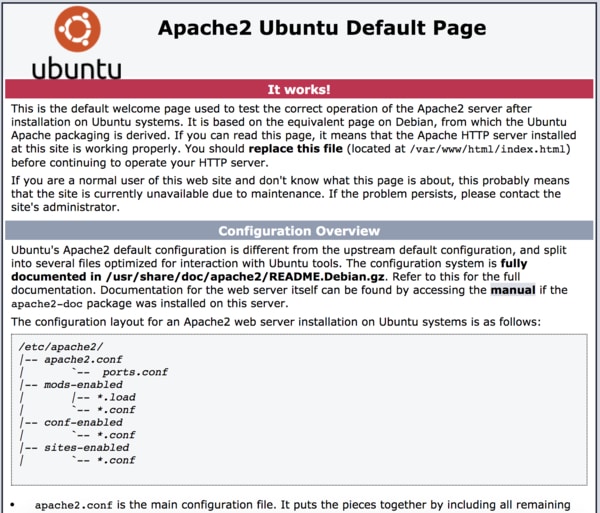
Good content takes time and effort to come up with.
Please consider supporting us by just disabling your AD BLOCKER and reloading this page again.

Install Apache Web Server On Ubuntu 20.04 / Linux & Manage It
Hello! In this tutorial, you will learn how to install Apache, Manage it & Create Virtual Hosts in Ubuntu 20.04. Apache web server is the most widely used web server in the market.
Prerequisites
Before moving ahead with this article I request you guys to setup up Ubuntu 20.04 server in Digital Ocean, Linode or any other cloud platform. If you don't have an account then click on the link and get the free credits to play around :)
You might be interested in securing your server after initial installation How To Do Basic Server Security Setup For Ubuntu / Linux.
Step 1 - Install Apache Web Server
First & foremost thing after logging into your server is to update the Ubuntu server packages so that the latest packages are available.
sudo apt update
Now install apache2 Web Server
sudo apt install -y apache2
Step 2 - Check The Apache Web Server Status
Now after you have installed your apache2 web server by default it will be running as system process.
To check the status of the apache2 server use the following service command
sudo service apache2 status
or using systemctl command
sudo systemctl status apache2
You will similar to the following output
apache2.service - LSB: Apache2 web server
Loaded: loaded (/etc/init.d/apache2; bad; vendor preset: enabled)
Drop-In: /lib/systemd/system/apache2.service.d
└─apache2-systemd.conf
Active: active (running) since Fri 2020-01-31 17:40:55 IST; 3 months 0 days ago
Docs: man:systemd-sysv-generator(8)
Process: 9350 ExecReload=/etc/init.d/apache2 reload (code=exited, status=0/SUCCESS)
Tasks: 20
Memory: 12.5G
CPU: 1month 2w 4d 9h 30min 45.734s
CGroup: /system.slice/apache2.service
├─22008 /usr/sbin/apache2 -k start
├─22245 /usr/sbin/apache2 -k start
Step 3 - Testing In Web Browser
Now to check if your server is running on it. Go to browser and type the server ip_address.
Use the following command in your logged in server to know the server ip_address.
hostname -I
It will return multiple ip_address with white space, try one by one. Most of the time first one will work.
Now with the above ip_address type as follows
http://server_ip_address
You must be able to see the following in your web page
Step 4 - Manage Apache Web Server
Once you have installed you have to manage it in future. There are 2 ways by which you can manage it with service or systemctl commands.
Start Apache Server
sudo service apache2 start
OR
sudo systemctl start apache2
Stop Apache Server
sudo service apache2 stop
OR
sudo systemctl stop apache2
Restart Apache Server
sudo service apache2 restart
OR
sudo systemctl restart apache2
Disable Auto Start After Reboot
sudo systemctl disable apache2
Enable Auto Start After Reboot
sudo systemctl enable apache2
Step 5 - Virtual Hosts Management
We use virtual hosts so that we can manage more than 1 website in single server. By default all domains will be pointing to /var/www/html folder.
For the sake of security & managing multiple website you need to point it to /var/www/ folder, which can have projects like /var/www/project_name
We will create first_domain & second_domain to mange it at /var/www folder.
NOTE: Replacefirst_domain&second_domainwith your domains
mkdir -p /var/www/first_domain/
mkdir -p /var/www/second_domain/
Now assign the main user ownership to first_domain & second_domain with $USER environment variable
For First Domain
sudo chown -R $USER:$USER /var/www/first_domain
For Second Domain
sudo chown -R $USER:$USER /var/www/second_domain
Make sure to give the proper file permissions for the project to work properly. Use the following command to allow root user read, write and execute permission and other to read & write permissions
First Domain
chown -R 755 /var/www/first_domain
Second Domain
chown -R 755 /var/www/second_domain
Create index.html files for the sake of testing
First Domain
sudo nano /var/www/first_domain/index.html
Add the following HTML content it index.html file
<!DOCTYPE html>
<html lang="en">
<head>
<title>First Domain</title>
</head>
<body>
<h1>First Domain Project!</h1>
</body>
</html>
Second Domain
sudo nano /var/www/second_domain/index.html
Add the following HTML content it index.html file
<!DOCTYPE html>
<html lang="en">
<head>
<title>Second Domain</title>
</head>
<body>
<h1>Second Domain Project!</h1>
</body>
</html>
Tell Apache To Server Which Domain Web Pages To Server
Now its time to tell which domain needs to access which project folder files.
Sites Available ( /etc/apache2/sites-available ) - Here we will place all our sites Apache configuration fileSite Enabled (/etc/apache2/sites-enabled) - Here all the enabled apache website configuration resides. This is usually points tosites-available.
By default you will have /etc/apache2/sites-available/000-default.conf configuration which will be pointing to /var/www/html/index.html folder file.
First Domain
sudo nano /etc/apache2/sites-available/first_domain.conf
And paste the following virtual host config data. The following code will tell that its listening on port 80 pointing to your first_domain which has an alias of ww.first_domain (this is non mandatory). We are storing the error & access logs in the default error & access logs path of apache.
<VirtualHost *:80>
ServerAdmin webmaster@localhost
ServerName first_domain
ServerAlias www.first_domain
DocumentRoot /var/www/first_domain/
ErrorLog ${APACHE_LOG_DIR}/error.log
CustomLog ${APACHE_LOG_DIR}/access.log combined
</VirtualHost>
Second Domain
sudo nano /etc/apache2/sites-available/second_domain.conf
And paste the following virtual host config data. The following code will tell that its listening on port 80 pointing to your second_domain which has an alias of ww.second_domain (this is non mandatory). We are storing the error & access logs in the default error & access logs path of apache.
<VirtualHost *:80>
ServerAdmin webmaster@localhost
ServerName second_domain
ServerAlias www.second_domain
DocumentRoot /var/www/second_domain/
ErrorLog ${APACHE_LOG_DIR}/error.log
CustomLog ${APACHE_LOG_DIR}/access.log combined
</VirtualHost>
NOTE: Apache logs exists in /var/log/apache2/ folderEnable & Disable The Configurations
Now you have added the configuration files for your server. To tell Apache server to load the changes of new configurations file and disable the default configuration file use the following
First Domain
sudo a2ensite first_domain.conf
Second Domain
sudo a2ensite second_domain.conf
Disable Default Config
sudo a2dissite 000-default.conf
Check For Configuration Error
To check if the configurations that we have add are all correct use the following command
sudo apache2ctl configtest
You should see the output similar to that of the following
Syntax Ok
Restart Apache Server
To make configurations take an effect and let apache server load those you need to restart the server with the command
sudo service apache2 restart
OR
sudo systemctl restart apache2
Testing Your Configurations In Browser
Load http://first_domain in your browser & http://second_domain in your browser to see successful pages.
Error Debugging
Sometimes you may get 404 page after doing all these. You can do the simple change in /etc/apache2/apache2.conf
Look for /var/www and change the code to below code
<Directory /var/www/>
Options Indexes FollowSymLinks
AllowOverride All
Require all granted
</Directory>
Conclusion
In this article you learnt how to setup Apache server, mange it & creating virtual hosts.
Articles For You
Factories To Speed Up Test-Driven Development In Laravel
Lazy Load YouTube And Other Videos In Website
Redirect www to a non-www Website Or Vice Versa
Install Letsencrypt SSL Certificate for RabbitMQ Server and RabbitMQ Management Tool
Client-Side DataTable, Adding Super Powers To HTML Table
Install RabbitMQ with Docker & Running with NodeJS
Simple Way To Create Resourceful API Controller In Laravel
Client-Side Form Validation With Javascript
Detect AdBlocker With Javascript And Increase Website Ads Revenue
Increase Session Timeout In Laravel
SummerNote WYSIWYG Text Editor
Setup AMP (Accelerated Mobile Pages) In PHP Laravel
NGINX Security Best Practices & Optimization
Install Packages Parallel For Faster Development In Composer










